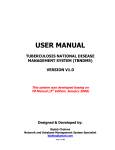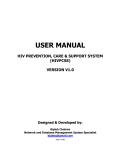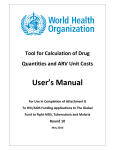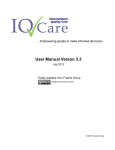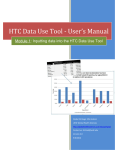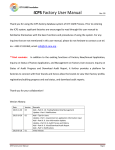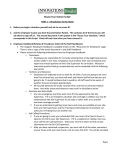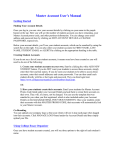Download USER MANUAL
Transcript
USER MANUAL HIV/AIDS NATIONAL DISEASE MANAGEMENT SYSTEM (HIVNDMS) VERSION V1.0 Designed & Developed by: Biplob Chakma Network and Database Management System Specialist [email protected] Page 1 of 80 Table of Contents Para No Title Name Page No Chapter 1: Introduction 1. Overview 2. Basic Features a. User Information b. Tabs, Menus, and Data Display Section c. Page and Current Menu d. Label, Button, Text Box, Check Box, Date Picker, and Drop Down List e. Grid View, Filter Section, Link Button, and Paging f. Data Loading Image g. Page Loading Sign h. Message for Must Entry Fields 5 5 5 6 6 8 9 10 11 13 Chapter 2 – Login, Logout, and Change Password 1. Login to HIVNDMS 2. Change Password 3. Logout from HIVNDMS 14 16 16 Chapter 3 – Basic Information Tab 1. Overview 2. District Menu 3. Sub District Menu 4. Position Category 5. Organization 17 17 19 21 22 Chapter 4 – VCCT Tab 1. Overview 2. VCCT Client Register Menu 3. VCCT Cycle Menu 4. Referral Record Menu 5. Training Menu 26 26 32 36 38 Chapter 5 – PMTCT Tab 1. Overview 2. Monthly PMTCT Reports Menu 3. Training Menu 41 41 46 Page 2 of 80 Chapter 6 – STI Tab 1. Overview 2. Monthly STI Case Reports Menu 3. Monthly STI Laboratory Reports Menu 4. Training Menu 49 49 51 53 Chapter 7 – ART Tab 1. Overview 2. ART Patient Register Menu 3. ART Follow-up Records Entry 4. Counselor Follow-up Records Entry 5. Family Members HIV History Entry 56 56 63 67 68 Chapter 8 – Administration Tab 1. Overview 2. Personnel Information 3. Assign Privilege Menu 7 71 74 Chapter 9 – Report Tab 1. Overview 2. VCCT Reports Menu 3. ART Reports Menu 4. PMTCT Reports Menu 5. STI Reports Menu 76 76 77 78 79 Page 3 of 80 How to Read this Manual This operator manual is arranged according to functionality grouping. All the similar category functionalities are arranged in different tabs. So the manual also covers each tab in each chapter. However, in order to have a HEAD START, the manual explains some of basic terminologies, basic features of the system. These are explained in Chapter 1 and Chapter 2. From Chapter 3 onwards, the manual explains all the features of the system starting with ‘Basic Information’. In the last two chapters, the manual also explains about how to generate reporting and how to administer the system. Page 4 of 80 Chapter 1 - Introduction 1. Overview Welcome to HIV National Disease Management System (HIVNDMS). If you are reading this manual, that means you have decided to know about the system; how to enter data, how to generate report and many others. HIVNDMS is a tool to capture data from VCCT register, ART register, STI and PMTCT monthly reporting formats. The system can also generate various types of reports; such as, list of VCCT clients from VCCT register, HIV+ve patients from ART register, and many other programmatic reports. So, before you begin, let’s take some time to explore the HIV National Disease Management System (HIVNDMS) tool (software/application) and learn about the basic features of navigation and transaction entry. This chapter provides an overview of the system and describes the elementary features of HIVNDMS. 2. Basic Features a. User Information Once you log into the system with correct credentials (Email ID and Password), you would be able to see the logged in user information at the top right corner of the system as shown below: Page 5 of 80 b. Tabs, Menus, and Data Display Section Once you log into the system with correct credentials (Email ID and Password), you would be able to see the tabs, menus, and data display section. Tabs are the collection of menus of related functionalities; whereas a Menu indicates a specific functionality under a tab. Such as, all types of reports are available under tab ‘Report’ and this report tab will have all the report menus; like VCCT Report, STI Report etc. Data Display Section (DDS) is the area where system will display the data; either for viewing or for adding a new record. All these features are shown in below image: c. Page and Current Menu Once you log into the system and click on a menu, then something appears on the right side of menu. This is called Page. Every menu will show a different page once it is clicked. However, in some places in the system a page may be loaded once a button is clicked. So, a Page is something where you’d view data or attempt to enter data. This is sometimes also referred to UI (User Interface). Page 6 of 80 Now, when you’d click on a menu it will load the related page. Notice a black arrow tip marked beside the menu. This indicates that the current menu is the one you’ve just clicked. All these features are shown in below image: Page 7 of 80 d. Label, Button, Text Box, Check Box, Date Picker, and Drop Down List Below image shows labels, buttons, text boxes, check box, and drop down lists: Buttons: Once clicked, it will do some action(s); such as, saving, editing etc. Text Box: User can type text here. Check Box: User can tick the box when appropriate. Drop Down List: User can choose one value from the given list. Page 8 of 80 Date Picker: User can enter a date in this box. If you click in this box, a date calendar will appear and then you’d be able to choose a date you want. Please note that, the format of date is US (United States) style i.e. it will show 4 March 2012 as ‘3/4/2012’, NOT as ‘4/3/2012’ i.e. in the format of ‘month/day/year’! Read-Only Text Box: User cannot type anything but just can view the information shown by the system. e. Grid View, Filter Section, Link Button, and Paging Below image shows grid view, filter section, link buttons, and paging section: Grid View (GV): A list where data are displayed Link Button: Similar to normal button i.e. when clicked, an action is done such as save, edit etc. Add a Sub District: Once clicked, it will load a page where you’d need to enter/type data and then do a save operation Edit: Once clicked, it will open existing record and then allow you to correct any existing data of that record Delete: Once clicked, it will delete/remove the record from system. Care should be taken while performing this action! Paging: When there are many data and cannot be displayed on one page in GV, then those data are listed in multiple pages i.e. page no 2, 3, and so on Page 9 of 80 Filter Section: Normally the GV shows all the data that is available in the system. But when you’d need to see some particular data then you’d need to use this filter section. Such as, to show/see only sub districts of Dili district, you’d need to select ‘Dili District’ from the DDL of the filter section and then click on ‘Apply Filter’ button. This will load all the sub districts of Dili only. Below image shows all the sub districts of Dili district: This is how the filter section works! There will certainly be more than one filter in the filter section in other pages. You’d just need to choose your desired filter and then do an ‘Apply Filter’ to show the data from system. The ‘Reset’ button in the filter section will set all the filter values to ‘none’ or ‘default’. f. Data Loading Image Whenever you try to load data from system, it will show an image indicating that it is now populating (downloading) data from online database and preparing to present in the GV. The image will look like as shown below: Page 10 of 80 You’d see this loading image when: (1) You are doing an ‘Apply Filter; or (2) You select an item from district DDL. This is because, it will load sub district DDL according to selected district; or (3) You select a report option and its associated filters get activated; or (4) During any other situation whenever the system remains busy in getting data from online you’ve requested it to do YOU SHOULD WAIT TILL THE IMAGE DISAPPEARS; BECAUSE IT IS NOT YET READY FOR YOU TO DO NEXT ACTION! g. Page Loading Sign The system also remains busy from the time a page is requested and till it gets loaded fully. However, this will not show any image; but instead, it will show a small rotating circle in the browser tab heading. This is shown below: Page 11 of 80 Page 12 of 80 h. Message for Must Entry Fields While you’d try to save a new record, there will be some field(s) that must be provided to get the record saved into the system. If you don’t provide those must entry information, the system will give you notification message. The message will be looking like shown below: Page 13 of 80 Chapter 2 – Login, Logout, and Change Password 1. Login to HIVNDMS Please do followings to login to HIVNDMS: (1) (2) Open Mozilla Firefox browser (use version 19 or later) Then go to this link: http://www.hivndms.tlhealthinformationsystem.com/ (3) This will load the login page as shown below: (4) Type: User ID (Email): login user email ID (Please note, this is NOT your personal email ID! This is the ID that is used to log into the HIVNDMS) Password: login password Type Code: Type the digits that you can see on the screen (this is to protect your account/system from spamming) Page 14 of 80 (5) You may or may not check the ‘Remember Password’; but if you are not using your own laptop or desktop, it is suggested NOT TO CHECK this check box! (6) Click ‘Login’ button to login to HIVNDMS and wait till you are logged in (7) After a successful login, you’d see below page: (8) If you’ve provided wrong information during login, then you’d see below message: In this case you try again with correct credentials to enter into the system. Page 15 of 80 2. Change Password Please do followings to change your password: (1) After login, click on the ‘Change Password’ link button at the top right corner of the HIVNDMS (2) This will load the change password page as shown below: (3) Type existing password, and then your new password two times and then click on ‘Change Password’ button to change your new password finally PLEASE SAVE YOUR NEW PASSWORD IN SAFE PLACE SO THAT YOU DON’T FORGET IT OR IT IS NOT DISCLOSED TO ANYONE! 3. Logout from HIVNDMS Please do followings to logout from HIVNDMS: (1) (2) After login, click on the ‘Logout’ link button at the top right corner of the HIVNDMS This will take you out off HIVNDMS and load login page again (for next login) Page 16 of 80 Chapter 3 – Basic Information Tab 1. Overview This tab contains the functionalities for entering basic information that are required for the system. Such as, district, sub district, staff position category etc. All these functionalities are realized by some menus. These menus are: (1) (2) (3) (4) (5) District Sub District Suco Position Category Organization If you click on ‘Basic Info’ tab, you’d be able to see above menus at the left and also data landing space i.e. data display section (DDS) at the right side. Please note that, you haven’t yet clicked on any menu and thus no menu is marked as current menu i.e. no red arrow tip at the left of selected menu. Note that, information under this tab are usually kind of one-time setting which you’d need to enter at the beginning of starting the system. Such as, you’d probably very rarely use district menu to add a new district because in not every year you’d have a new district in your country! 2. District Menu This menu is to set up district information. Click on ‘District’ menu to go to district page. You’d see all the available districts in the GV list. You may see paging depending on amount of record i.e. you may need to go to multiple pages to view all the districts. The district GV will look like: Page 17 of 80 In order to add a new district, do followings: (1) Click on ‘Add a District’ link button (2) You’d see below page: (3) Type ‘Full Name’, district ‘Code’ and then check ‘Is Capital’ if it is the capital of the country (4) Once all information are given, click on ‘Save’ or ‘Save & Close’ button to finally save the new district information Note that, if you’ve chosen Save, you would still remain on the same page and if you’ve chosen Save & Close button then you’d come back to district list GV. Page 18 of 80 3. Sub District Menu This menu is to enter sub district information. Click on ‘Sub District’ menu to go to sub district page. You’d see all the available sub districts in the GV list. You may see paging depending on amount of record i.e. you may need to go to multiple pages to view all the sub districts. The sub district GV will look like: Note in the above GV list that, it is showing all the sub districts. At this point you may do an ‘Apply Filter’ to view sub district of a specific district. To do this, do followings: (1) Select a district (say, Dili) from DDL in the filter section (2) Then click on ‘Apply Filter’ (3) Notice that, the GV is now filled with all sub districts of district Dili Page 19 of 80 In order to add a new sub district, do followings: (1) Click on ‘Add a Sub District’ link button (2) You’d see below page: (3) Select one district under which you’d like to add this new sub district, then type ‘Full Name’, sub district ‘Code’ and then check ‘Is Capital’ if it is the capital of the selected district (4) Once all information are given, click on ‘Save’ or ‘Save & Close’ button to finally save the new district information Note that, if you’ve chosen Save, you would still remain on the same page and if you’ve chosen Save & Close button then you’d come back to sub district list GV. Page 20 of 80 4. Position Category This menu is to set up staffs’ position category information. Click on ‘Position Category’ menu to go to staffs’ position category page. You’d see all the available staffs’ positions in the GV list. You may see paging depending on amount of record i.e. you may need to go to multiple pages to view all the staffs’ positions. The staffs’ position category GV will look like: In order to add a new position category, do followings: (1) Click on ‘Add a Position Category’ link button (2) You’d see below page: Page 21 of 80 (3) Type ‘Category Name’, ‘Short Name’, and ‘Category Level’ (4) Once all information are given, click on ‘Save’ or ‘Save & Close’ button to finally save the new district information Note that, if you’ve chosen Save, you would still remain on the same page and if you’ve chosen Save & Close button then you’d come back to sub district list GV. 5. Organization This menu is to enter organization’s information. Click on ‘Organization’ to go to organization page. You’d see all the available organizations in the GV list. You may see paging depending on amount of record i.e. you may need to go to multiple pages to view all the staffs’ positions. The staffs’ position category GV will look like: Page 22 of 80 At this point you may do an ‘Apply Filter’ to view organizations as per district, sub district, and service type. To do this, do followings: (1) Select a district (say, Aileu) from DDLs in the filter section (2) Then click on ‘Apply Filter’ (3) Notice that, the GV is now filled with all organizations under district Aileu In order to add a new organization, do followings: (1) Click on ‘Add an Organization’ link button (2) You’d see below page: Page 23 of 80 (3) Type or select below information: Organization Name*: Name of the organization. District*: The district where you want to add this organization. Sub District*: The sub district where you want to add this organization. Suco: The suco where you want to add this organization. Address: Address of the organization. Contact Person Name: Name of contact person. Designation: Designation of the contact person. Contact Number: Contact number of the organization. Is an SDP: Specify whether the new organization is a service delivery point. Organization Type: This will only be enabled if you’ve checked ‘Is an SDP’. This is to specify the type of service delivery point for this organization; such as, CHC or HNGV etc. Service Provided: The services that the organization will provide; such as, TB, PMTCT, ANC, VCCT etc. If you don’t choose appropriate service types, you would not see the desired organization in the organization DDL. Such as, if you don’t select ‘TB SDP’ then that organization will NOT APPEAR in the Organization Facility page GV. Service Delivery Start: At what time the organization starts its service. Service Delivery End: At what time the organization ends its service. Service Change: Amount (in US$) that is charged for each service. Transportation Details: How to reach the organization. Important! Field with * marking is a mandatory field that must be provided to save an organization. If you don’t provide that information, system will not save the organization and will show error message in red text. Page 24 of 80 (4) Once all information are given, click on ‘Save’ or ‘Save & Close’ button to finally save the new district information Note that, if you’ve chosen Save, you would still remain on the same page and if you’ve chosen Save & Close button then you’d come back to sub district list GV. Page 25 of 80 Chapter 4 – VCCT Tab 1. Overview This tab contains the functionalities for entering VCCT register and monthly follow-up data; such as, VCCT client registration, monthly follow up data etc. All these functionalities are realized by some menus. These menus are: (1) (2) (3) (4) VCCT Client Register VCCT Cycle Referral Records Training If you click on ‘VCCT’ tab, you’d be able to see above menus at the left and also the data landing space i.e. data display section (DDS) at the right side. Please note that, you haven’t yet clicked on any menu and thus no menu is marked as current menu i.e. no red arrow tip at the left of selected menu. This is the main section of the system that will be used by most users and most of the time. 2. VCCT Client Register Menu This menu is to do client registration into VCCT register. Click on ‘VCCT Client Register’ menu to go to client registration page. To see the patients list of a particular registration unit do followings: (1) (2) (3) Select a VCCT Center (say, CHC Bairo Pite and then click on ‘Apply Filter’ button. This will list all the VCCT clients from CHC Bairo Pite. The page will look like as shown below: Page 26 of 80 (4) Please note that, you can do further filtering to see more specific patients. Such as, if you are willing to see a particular client then you’d need to use filters Client Name, System PID, and VCCT PID. If you do Apply Filter with these 3 filters, then you will see your desired list in the GV. (5) Like this, you can choose various filters to view different patients list. (This remaining part of the page is intentionally kept blank) Page 27 of 80 In order to add a new VCCT client, do followings: (1) Click on ‘Register New Client’ link button (2) You’d see below page: (3) Notice that, you cannot click on first text box i.e. PID Code. This is because this box is used by system to show System PID (NOT the VCCT PID). (4) Type or select below information: VCCT Center*: Name of center where the client is being registered. Registration Date*: Date of registration. Referred from*: This is the Entry Type of the client i.e. from where or how the client is coming for VCCT. Manual VCCT Code*: This is the VCCT PID. First Name (3 letters)*: First 3 letters from client’s name. Page 28 of 80 Mother’s Name (3 letters)*: First 3 letters of client’s mother name. Father’s Name (3 letters)*: First 3 letters of client’s father name. Is DoB Exact: Most of the cases you’d not need to check this box as because exact date of birth may not be available. Instead, you’d need to enter age of the client on the registration day. Please note that, if you’ve chosen Is DoB Exact box, then you will see a date entry box; you will not see the age boxes. Date of Birth: Date of birth of the client. Age*: Age of the client during on the registration date. There are two boxes; one is for year and another is for month. For example, if you’d like to enter age as 30 yrs 8 months, then you’d need to type 30 in the first box and 8 in the second box. Please note that, if you’ve chosen Is DoB Exact box, then you will see a date entry box for entering Date of Birth; you will not see these age boxes. Sex*: Sex of the client. Marital Status: Marital status of the client. Profession: Profession of the client. Contact No: Contact number of the client. District*: Permanent district of the client. Sub District*: Permanent sub district of the client. Address: Permanent address of the client. Important! Field with * marking is a mandatory field that must be provided to save a TB patient. If you don’t provide that information, system will not save the patient and will show error messages in red text. (5) Once all information are given, click on ‘Save’ or ‘Save & Close’ button to finally save the new district information Note that, if you’ve chosen Save, you would still remain on the same page and if you’ve chosen Save & Close button then you’d come back to GV page. Page 29 of 80 Search Client (Patient) Functionality During VCCT registration, it is also possible to populate a client from other systems; such as a TB patient coming for VCCT. The TB patient is already in the system and we can just tag that patient in the VCCT register. This is also possible for a person from beneficiary category MSM, FSW, CoSW, or even IDU provided that person already registered in the system before and he/she is coming for VCCT with a referral card. This functionality is to ensure a better tracking of a person and also does not allow making duplicate entries of the same person. To tag an existing client/patient in the VCCT register, do followings: (1) Make sure you are on the ‘VCCT Client Registration’ details page (2) You’d see one button ‘Search Patient’ at the top of the page and at the left of button ‘Save & Close’ as shown below: (3) (4) Click on ‘Search Patient’ button You’d see below page: Page 30 of 80 (5) In the above GV, you’d see a list of all individual persons who have been registered previously. They could be in TB system, Prevention, Care & Support System (6) Like other GV pages, you can also filter to search for your desired person who has come for VCCT registration (7) Say, for example, a TB patient (TB No: 30, Reg. Year: 2013, Reg. Unit: CHC Bairo Pite) has come for VCCT for the first time and you are now registering that TB patient in VCCT register. All what you will be doing is to tag that patient to VCCT register; that’s it! (8) So, now you check the TB check box (2nd line) and then enter all the information. (9) Once done, click on ‘Apply Filter’ button and you will see that system has brought that TB patient in the list. (10) Now you click on ‘Select’ link button and this will take you back to the ‘VCCT Registrtion’ details page i.e. from where you’ve come in this GV page! Page 31 of 80 (11) In the ‘VCCT Registration’ page you notice that system has automatically populated the basic information like Name, Father Name, Mother Name, Age etc. So, you will not required to type these information again here during VCCT registration. (12) Please remember, saying again, all what you are doing is tagging an existing patient/client in order to stop duplication. 3. VCCT Cycle Menu This menu is to record/save VCCT details of clients (from physical VCCT register). Click on ‘VCCT Cycle’ menu to go to the VCCT cycle page. To see the clients of a particular VCCT center do followings: (1) (2) (3) Select a VCCT Center (say, CHC Bairo Pite and then click on ‘Apply Filter’ button. This will list all the VCCT details of CHC Bairo Pite. The page will look like as shown below: (4) Please note that, you can do further filtering to see more specific clients. Such as, if you are willing to see a particular client’s VCCT details then you’d need to use System PID, and VCCT PID. You can also filter the VCCT records from specific period using filters Pre-Test from Date and Post-Test from date. Page 32 of 80 In order to add new VCCT details of a client, do followings: (1) Click on ‘Add VCCT Cycle’ link button (2) You’d see below page: (3) Notice that, you cannot click on first 3 text boxes i.e. PID Code (System PID), VCCT Code, and VCCT Center. This is because you are required to select a VCCT client from the VCCT register! Page 33 of 80 (4) So, first of all, you will need to select a VCCT client whose VCCT details you are going to enter now. Click on ‘Search Patient’ button and then you will see the Search Patient GV. Now you select that VCCT client by doing a filter with correct information. This was explained above under VCCT Cycle Menu. (5) At this level, you should be in the ‘VCCT Cycle Details’ page. If so, you would also be able to see the information the top 3 boxes. Now you need to enter VCCT cycle data. (6) Type or select below information: Pre-Test Counseling Date*: Date of pre-test counseling. Consent Type*: Written or Verbal or Opt Out. Test Date*: Date of HIV testing. Test Result Date*: Date of HIV test result. Test Result (Final)*: HIV test result. CD4 Count: CD4 count. Viral Load: Viral load. Post-Test Counseling Date*: Date of post-test counseling. Confirmation Date: HIV+ve confirmation test result date. Final Remarks: To add any other information that are not covered in other boxes. Client Referred To: To where a VCCT client is referred after post-test counseling. Was C&S Group Representative Present in Post-Test Counseling: Whether the Care & Support Counselor was present during the VCCT counseling. C&S Counselor Name: Name of Care & Support Counselor. C&S Counselor Position: Position of Care & Support Counselor. C&S Organization: Organization of Care & Support Counselor. (7) You can also enter further details information if you want. This information is not visible when you load the VCCT cycle page. To see this information, you will need to click on link button ‘Show additional information’. Once you click on this link button, you will see below section in the same page: Page 34 of 80 (8) Type or select below information: Likely Risk Group: Risk group of the client. Likely Route of HIV Transmission: Probable HIV transmission route. Risk Reduction Plan: Risk reduction plan advised for client. Medical History: Medical history of client. Is Family Member having VCCT PID: Whether client’s member has done VCCT before nor not; and if yes, then also provide VCCT PID. In order to find that PID, click on button ‘Find PID’ and then ‘Search Client’ pop-up will appear as shown below: Page 35 of 80 Now search the client just like explained above under this same menu. Comments: Type any further information that was not captured above. Important! Field with * marking is a mandatory field that must be provided to save a TB patient. If you don’t provide that information, system will not save the patient and will show error messages in red text. (9) Once all information are given, click on ‘Save’ or ‘Save & Close’ button to finally save the new district information Note that, if you’ve chosen Save, you would still remain on the same page and if you’ve chosen Save & Close button then you’d come back to GV page. 4. Referral Record Menu This menu is to save VCCT clients referral information. When you will need to transfer a patient for TB testing this is called ‘Referral to TB’. Similarly, when a TB patient is referred for HIV testing i.e. VCCT, then this is called ‘Referral from TB’. So, this menu implements following two functionalities: (1) Refer a VCCT client for TB testing; and (2) Register a TB patients into VCCT register who is referred to VCCT (from TB system) Page 36 of 80 The entire process is fully automatic and hence it is called ‘Live Referral’. Important! You will not see a VCCT client in the TB system unless he/she is not transferred from VCCT system and vice versa. Now, please notice that, there are two tabs in the Data Display Section (DDS) of this page. These are: (1) Referral Record OUT List: clients those have been referred to other services; such as TB (2) Referral Record IN List: patients those have been referred from other system; such as TB In order to refer a VCCT client to TB or any other services, do followings: (1) Click on ‘Add a Referral Record’ link button (2) Below page will be loaded: (3) Type or select below information: PID Code*: VCCT PID code. Referred Date*: Date of referral from VCCT. Referring Unit*: VCCT center. Referred by*: Referred by person. Referral Reason*: Reason for referral. Referred to Unit*: Unit where the patient is being transferred. Referred to Person Name: Name of the person to whom the client is referred. Page 37 of 80 Referred to Person Position: Position of the person to whom the client is referred. Important! Field with * marking is a mandatory field that must be provided to save a TB treatment details. If you don’t provide that information, system will not save the information and will show error messages in red text. (4) Once all information are given, click on Save or Save & Close button to finally save the new district information Note that, if you’ve chosen Save, you would still remain on the same page and if you’ve chosen Save & Close button then you’d come back to TB treatment details GV page. 5. Training Menu This menu is to save training records. Click on ‘Training’ menu to go to training GV page. The page will look like as shown below: In order to add a new training and its participants details, do followings: (1) Click on ‘Add a New Training’ (2) You’d see below page: Page 38 of 80 (3) Type or select below information: Training Name*: Name of training. Training Type*: Type of training. Training Place: Date on which test was done. Start Date*: Training start date. Till Date*: Training end date. Trainer Name*: Name of the trainer. Training Location: Details of training place (venue). Total Participants: Total number of participants. Important! Field with * marking is a mandatory field that must be provided to save a TB test result details. If you don’t provide that information, system will not save the information and will show error messages in red text. (4) Once all information are given, click on ‘Save’ or ‘Save & Close’ button to finally save the new district information Note that, if you’ve chosen Save, you would still remain on the same page and if you’ve chosen Save & Close button then you’d come back to TB test result details GV page. (5) Notice that there are two link buttons against each training; those are ‘Add’ and ‘List’ Page 39 of 80 (6) Use ‘Add’ link button to add a trainee and use ‘List’ when you want to see the list of all trainees of a training (7) The page where you can enter trainee details looks like shown below: (8) If you click on ‘List’ link button, the participants list will appear as shown below: Page 40 of 80 Chapter 5 – PMTCT Tab 1. Overview This tab contains the functionalities for entering PMTCT data from periodic reports such as, PMTCT monthly reports, training reports etc. 2. Monthly PMTCT Reports Menu This menu is to save records from monthly PMTCT reports. Click on ‘Monthly PMTCT Reports’ menu to go to the monthly PMTCT report page. The GV page will look like shown below: To see some particular PMTCT monthly reports, do followings: (1) Select a PMTCT Center (say, CHC Dili (Formoza)), 2013 as Year and then click on ‘Apply Filter’ button. (2) This will list all the PMTCT monthly reports of 2013 from CHC Dili (Formoza). (3) The list will now look like as shown below: Page 41 of 80 In order to add new PMTCT monthly report, do followings: (1) Click on ‘Add a Monthly PMTCT Report’ link button (2) You’d see below page: (3) Type or select below information: Date of Reporting*: Date of reporting. Reporting Period*: Reporting period. Name of Reporting Center*: Reporting PMTCT center. Name of In-Charge Reporting Officer: Name of the person sent the report. Important! Field with * marking is a mandatory field that must be provided to save a TB patient. If you don’t provide that information, system will not save the patient and will show error messages in red text. (4) Once all information are given, click on ‘Save’ or ‘Save & Close’ button to finally save the new district information Note that, if you’ve chosen Save, you would still remain on the same page and if you’ve chosen Save & Close button then you’d come back to GV page. Page 42 of 80 (5) Once you have entered a PMTCT report, notice that there is there are several link buttons. Each of these link buttons implements the functionality of each section of the PMTCT report. See below for details: Program Data Link Buttons: to enter the data of Program Data section from the PMTCT monthly report. Staff Status Link Buttons: to enter the data of Staff Data section from the PMTCT monthly report. Visit Link Buttons: to enter the data of Monitoring Visit section from the PMTCT monthly report. Miscellaneous Link Buttons: to enter the data of Register and Others section from the PMTCT monthly report. Cohort ED Link Buttons: to enter the data of Cohort of Expected Delivery (ED) section from the PMTCT monthly report. Drug & Kit Stock Link Buttons: to enter the data of Drug & Kit Stock section from the PMTCT monthly report. (6) In order to add program data information click on corresponding ‘Add’ link button. The page will look like below: Page 43 of 80 (7) In order to add staff status data information click on corresponding ‘Add’ link button. The page will look like below: (8) In order to add visit details data information click on corresponding ‘Add’ link button. The page will look like below: (9) In order to add miscellaneous data information click on corresponding ‘Add’ link button. The page will look like below: Page 44 of 80 (10) In order to add miscellaneous data information click on corresponding ‘Add’ link button. The page will look like below: (11) In order to add miscellaneous data information click on corresponding ‘Add’ link button. The page will look like below: Page 45 of 80 3. Training Menu This menu is to save training records. Click on ‘Training’ menu to go to training GV page. The page will look like as shown below: In order to add a new training and its participants details, do followings: (1) Click on ‘Add a New Training’ (2) You’d see below page: Page 46 of 80 (3) Type or select below information: Training Name*: Name of training. Training Type*: Type of training. Training Place: Date on which test was done. Start Date*: Training start date. Till Date*: Training end date. Trainer Name*: Name of the trainer. Training Location: Details of training place (venue). Total Participants: Total number of participants. Important! Field with * marking is a mandatory field that must be provided to save a TB test result details. If you don’t provide that information, system will not save the information and will show error messages in red text. (4) Once all information are given, click on ‘Save’ or ‘Save & Close’ button to finally save the new district information Note that, if you’ve chosen Save, you would still remain on the same page and if you’ve chosen Save & Close button then you’d come back to TB test result details GV page. (5) Notice that there are two link buttons against each training; those are ‘Add’ and ‘List’ Page 47 of 80 (6) Use ‘Add’ link button to add a trainee and use ‘List’ when you want to see the list of all trainees of a training (7) The page where you can enter trainee details looks like shown below: (8) If you click on ‘List’ link button, the participants list will appear as shown below: Page 48 of 80 Chapter 6 – STI Tab 1. Overview This tab contains the functionalities for entering STI data from periodic reports such as, STI monthly reports, training reports etc. 2. Monthly STI Case Reports Menu This menu is to save records from monthly STI case reports. Click on ‘Monthly STI Case Reports’ menu to go to the monthly STI case report page. The GV page will look like shown below: To see some particular STI case monthly reports, do followings: (1) Select a STI Center (say, CHC Dili (Formoza)), 2013 as Year and then click on ‘Apply Filter’ button. (2) This will list all the STI case monthly reports of 2013 from CHC Dili (Formoza). (3) The list will now look like as shown below: Page 49 of 80 In order to add new STI case monthly report, do followings: (1) Click on ‘Add a Monthly STI Case Report’ link button (2) You’d see below page: (3) Type or select below information: Reporting Period*: Reporting Month and Year. Reporting Unit*: Reporting STI center. Reporting Person: Name of the person sent the report. STI Case Values: All STI syndrome cases as per age group. Page 50 of 80 Important! Field with * marking is a mandatory field that must be provided to save a TB patient. If you don’t provide that information, system will not save the patient and will show error messages in red text. (4) Once all information are given, click on ‘Save’ or ‘Save & Close’ button to finally save the new district information Note that, if you’ve chosen Save, you would still remain on the same page and if you’ve chosen Save & Close button then you’d come back to GV page. 3. Monthly STI Laboratory Reports Menu This menu is to save records from monthly STI laboratory reports. Click on ‘Monthly STI Laboratory Reports’ menu to go to the monthly STI laboratory report page. The GV page will look like shown below: To see some particular STI laboratory monthly reports, do followings: (1) Select a STI Center (say, CHC Dili (Formoza)), 2013 as Year and then click on ‘Apply Filter’ button. (2) This will list all the monthly STI laboratory reports of 2013 from CHC Dili (Formoza). (3) The list will now look like as shown below: Page 51 of 80 In order to add new STI monthly report, do followings: (1) Click on ‘Add a Monthly STI Laboratory Report’ link button (2) You’d see below page: (3) Type or select below information: Reporting Period*: Reporting Month and Year. Reporting Unit*: Reporting STI center. Reporting Person: Name of the person sent the report. STI Laboratory Values: All STI laboratory data as per age group. Important! Page 52 of 80 Field with * marking is a mandatory field that must be provided to save a TB patient. If you don’t provide that information, system will not save the patient and will show error messages in red text. (4) Once all information are given, click on ‘Save’ or ‘Save & Close’ button to finally save the new district information Note that, if you’ve chosen Save, you would still remain on the same page and if you’ve chosen Save & Close button then you’d come back to GV page. 4. Training Menu This menu is to save training records. Click on ‘Training’ menu to go to training GV page. The page will look like as shown below: In order to add a new training and its participants details, do followings: (1) Click on ‘Add a New Training’ (2) You’d see below page: Page 53 of 80 (3) Type or select below information: Training Name*: Name of training. Training Type*: Type of training. Training Place: Date on which test was done. Start Date*: Training start date. Till Date*: Training end date. Trainer Name*: Name of the trainer. Training Location: Details of training place (venue). Total Participants: Total number of participants. Important! Field with * marking is a mandatory field that must be provided to save a TB test result details. If you don’t provide that information, system will not save the information and will show error messages in red text. (4) Once all information are given, click on ‘Save’ or ‘Save & Close’ button to finally save the new district information Note that, if you’ve chosen Save, you would still remain on the same page and if you’ve chosen Save & Close button then you’d come back to TB test result details GV page. (5) Notice that there are two link buttons against each training; those are ‘Add’ and ‘List’ Page 54 of 80 (6) Use ‘Add’ link button to add a trainee and use ‘List’ when you want to see the list of all trainees of a training (7) The page where you can enter trainee details looks like shown below: (8) If you click on ‘List’ link button, the participants list will appear as shown below: Page 55 of 80 Chapter 7 – ART Tab 1. Overview This tab contains the functionalities for entering ART register and monthly follow-up data; such as, ART registration, monthly follow up data etc. All these functionalities are realized by some menus. These menus are: (1) (2) ART Patient Register Training If you click on ‘ART tab, you’d be able to see above menus at the left and also the data landing space i.e. data display section (DDS) at the right side. Please note that, you haven’t yet clicked on any menu and thus no menu is marked as current menu i.e. no red arrow tip at the left of selected menu. 2. ART Patient Register Menu This menu is to do HIV+ve patient registration into ART register. Click on ‘ART Patient Register’ menu to go to client registration page. To see the patients list of a particular registration unit do followings: (1) Select a Cohort Unit (say, Referral Hospital Maliana) and then click on ‘Apply Filter’ button. (2) This will list all the HIV+ve patients from Referral Hospital Maliana. (3) The page will look like as shown below: Page 56 of 80 (4) Please note that, you can do further filtering to see more specific patients. Such as, if you are willing to see a particular patient then you’d need to use ART Code and do an ‘Apply Filter’. Like this, you can choose various filters to view different patients list. In order to register a new HIV+ve patient, do followings: (1) Click on ‘Register New Patient’ link button (2) You’d see below page: Page 57 of 80 Page 58 of 80 (3) Notice that, you cannot click on first two boxes i.e. PID Code and Cohort Unit. This is because this information will be shown automatically by the system. (4) Type or select below information: PID Code: System PID (NOT ART Code). Cohort Unit: Unit where the patient is receiving treatment currently. Registration Unit*: Registration unit. Registration Date*: Date of registration. Center Code*: This is the ART Code given from ART registration center. Code Name*: First 3 letters from patient’s name. Mother’s Name (3 letters)*: First 3 letters of patient’s mother name. Father’s Name (3 letters)*: First 3 letters of patient’s father name. District*: Permanent district of the patient. Sub District*: Permanent sub district of the patient. Suco: Permanent suco of the patient. Address: Permanent address of the patient. Is DoB Exact: Most of the cases you’d not need to check this box as because exact date of birth may not be available. Instead, you’d need to enter age of the patient on Page 59 of 80 the registration day. Please note that, if you’ve chosen Is DoB Exact box, then you will see a date entry box; you will not see the age boxes. Date of Birth: Date of birth of the patient. Age*: Age of the client during on the registration date. There are two boxes; one is for year and another is for month. For example, if you’d like to enter age as 30 yrs 8 months, then you’d need to type 30 in the first box and 8 in the second box. Please note that, if you’ve chosen Is DoB Exact box, then you will see a date entry box for entering Date of Birth; you will not see these age boxes. Sex*: Sex of the patient. Marital Status: Marital status of the patient. Profession: Profession of the patient. Education: Education level of the patient. Emergency Contact Person: Details of emergency contact person of the patient. Relation with Patient: Relationship with the patient. Type of Entry*: From where or how the patient has come. Date of Confirmation HIV: Confirm HIV+ve date. ARV Start Date: ARV start date. ARV Drug Name: Name of ARV drug. Is Having TB: Check if the patient is having TB co-infection. BMI on Registration: BMI. Medicine Allergy Details: Description on patient’s allergy to medicine. Can HIV Care & Support Org. Make Contact?: Check this if the patients wants to be contacted with HIV care and support organization(s). Please note that, if you don’t select this, the patients will NOT BE VISIBLE in the HIV Prevention, Care and Support System (HIVPCSS). Like to be Included into PLHIV Network?: Check this if the patients wants to be connected into PLHIV network. Please note that, if you don’t select this, the patients will NOT BE VISIBLE in the HIV Prevention, Care and Support System (HIVPCSS). HIV C&S Representative info: Name: Name of HIV care and support person. Position: Position of HIV care and support person. Organization: Organization of the care and support person. Important! Field with * marking is a mandatory field that must be provided to save a TB patient. If you don’t provide that information, system will not save the patient and will show error messages in red text. Page 60 of 80 (5) Once all information are given, click on ‘Save’ or ‘Save & Close’ button to finally save the new district information Note that, if you’ve chosen Save, you would still remain on the same page and if you’ve chosen Save & Close button then you’d come back to GV page. Search Client (Patient) Functionality During ART registration, it is also possible to populate a VCCT client; such as a clients who is already been registered into VCCT register. Using ‘Search Patient’ functionality you can just tag that patient in the ART register while doing ART registration. This functionality is to ensure a better tracking of a person and also does not allow making duplicate entries of the same person. To tag an existing client while doing ART registration, do followings: (1) Make sure you are on the ‘ART Registration’ details page (2) You’d see one button ‘Search Patient’ at the top of the page and at the left of button ‘Save & Close’ as shown below: (3) (4) Click on ‘Search Patient’ button You’d see below page: Page 61 of 80 (5) In the above GV, you’d see a list of all individual persons who have been registered previously. They could be in HIV system or even in TB system or Prevention, Care & Support System (6) As explained under ‘VCCT Client Register’ menu, you can do a search to find out the VCCT client and then when you’ve identified the client, click on ‘Select’ link button Important! It is recommended to tag EVERY HIV+ve patients while doing registration. Because, as per national VCCT guideline, VCCT is the ONLY DOOR for accessing ART i.e. every HIV+ve patient WILL HAVE a VCCT CODE. You must use that code to make sure that same person is not entered duplicate! As you look at the ART GV, you will notice that there are 4 columns with link buttons against each HIV+ve patient. Those are: (1) Family Members HIV History Column: Use this link button to enter family members HIV history of the HIV+ve patient. (2) ART Follow-up Records Column: Use this link button to enter ART follow-up records of HIV+ve patient. (3) Counselor’s Follow-up Records Column: Use this link button to enter counselors’ time to time follow-up records of HIV+ve patients. (4) Prescription Records Column: Use this link button if you want to see the prescription details of HIV+ve patients. Page 62 of 80 3. ART Follow-up Records Entry This functionality is to record ART follow-up records of HIV+ve patients. This is NOT implemented through any menu; instead, this is done from the ART register GV page. To add ART follow-up records, do followings: (1) (2) (3) Make sure that you are on the ART Register GV page Click on ‘Add/Edit’ link button of column ART Follow-up Records of the HIV+ve patient This will load a page that will look like shown below: This GV shows the list of all ART follow-up records of that patient. To add a new ART follow-up record, do followings: (1) click on ‘Add ART Follow-up Record’ link button and the page will get loaded which will look like shown below: Page 63 of 80 (2) Type or select below information: Patient ART Code: HIV+ve patient’s ART code (shown automatically by system and cannot be changed). Visit Date*: Date of ART follow-up. Next Visit Date: Date when the patient is suggested to come next time for ART follow-up. Visit Type*: Type of visit. Visiting Unit*: Unit where the patient has come for ART follow-up. Reason for Visiting: Reason for ART follow-up visit. Contact Number: Contact number of the patient. Pulse: Pulse during visit. Temperature: Temperature during visit. Blood Pressure: Blood pressure during visit. BMI: BMI during visit. Height: Height during visit. Weight: Weight during visit. Complain Details: Complains from patients. Interview Details: Doctor’s remarks on the ART follow-up interview regarding patient’s overall status. Diagnostic Details: Diagnostic details of the patient. Medical Prescription Comments: Prescription details given by doctor. WHO Clinical Stage: WHO clinical stage determined by doctor. There are some more additional information you can enter; such as physical examination details and blood test report information. To do that, do following: (1) Click on link button ‘Show Physical Examination Details’ and below information will appear: Page 64 of 80 (2) Now type appropriate details in the boxes. (3) Now click on link button ‘Show Blood Test Report’ and below information will appear: (4) Now type appropriate details in the boxes. Important! Field with * marking is a mandatory field that must be provided to save a TB patient. If you don’t provide that information, system will not save the patient and will show error messages in red text. (5) Once all information are given, click on ‘Save’ or ‘Save & Close’ button to finally save the new district information Note that, if you’ve chosen Save, you would still remain on the same page and if you’ve chosen Save & Close button then you’d come back to GV page. To add prescription records, do followings: Page 65 of 80 (1) (2) you (3) (4) Make sure that you are on ART Follow-up GV page i.e. list of all ART follow-up records. Click on the link button ‘Add’ at very right side of the ART follow-up record for which are going to add prescription details. Following page will appear: Now type or select followings: ARV Drug Name*: ARV drug name as prescribed by doctor. ARV Start Date*: Start date of above ARV. Prescription Period: For how many months the drug is given to the patient. Dose Amount: Dose amount of the drug i.e. amount of drug to be swallowed. Code: Treatment code. Impact: Expected impact (if any) as described by doctor. Important! Field with * marking is a mandatory field that must be provided to save a TB patient. If you don’t provide that information, system will not save the patient and will show error messages in red text. (5) Once all information are given, click on ‘Save’ or ‘Save & Close’ button to finally save the new district information Note that, if you’ve chosen Save, you would still remain on the same page and if you’ve chosen Save & Close button then you’d come back to ART Follow-up Record GV page. Page 66 of 80 (6) Now click on ‘Back’ button (at the top right side of the GV) to go back to ART Register GV page. 4. Counselor Follow-up Records Entry This functionality is to record ART counselors’ follow-up records of HIV+ve patients. This is NOT implemented through any menu; instead, this is done from the ART register GV page. To add ART follow-up records, do followings: (1) Make sure that you are on the ART Register GV page (2) Click on ‘Add/Edit’ link button of column Counselor’s Follow-up Records of the HIV+ve patient (3) This will load a page that will look like shown below: This is the list of all counselor follow-up records of selected HIV+ve patient. Now, to add a counselor follow-up record, do followings: (1) Make sure you are in the Counselor Follow-up GV page (shown above). (2) Click on link button ‘Add ART Counselor Periodic Follow-up Record’ (3) This will load below page: Page 67 of 80 (4) Type or select followings: Follow-up Date*: Date on which counselor did the follow-up. Note that, follow-up date must be greater than registration date! Follow-up Type*: Type of follow-up. Follow-up Status*: Status of the patient during follow-up. Counselor Name: Name of counselor did follow-up. Counselor Position: Position of counselor. (5) Now click on ‘Back’ button (at the top right side of the GV) to go back to ART Register GV page. 5. Family Members HIV History Entry This functionality is to record family members’ information of HIV+ve patients. This is NOT implemented through any menu; instead, this is done from the ART register GV page. To add ART follow-up records, do followings: (1) Make sure that you are on the ART Register GV page (2) Click on ‘Add/Edit’ link button of column Family Members HIV History of the HIV+ve patient (3) This will load a page that will look like shown below: This is the list of all family members’ HIV history/records of selected HIV+ve patient. Now, to add family members’ records, do followings: (1) Make sure you are in the Family Members HIV History GV page (shown above). (2) Click on link button ‘Add Family Members HIV History’ (3) This will load below page: Page 68 of 80 (4) Type or select followings: Relationship*: Relationship with the patient. Family Member’s Age*: Age of the family member. Is HIV Test Done: Check if HIV test done for this family member. HIV Test Result*: HIV test result (this is must entry if you have chosen Is HIV Test Done above). ART Code of Family Member: ART code of family member. Tag this family member through Search Patient functionality explained under ‘ART Patient Register’ menu. Important! Field with * marking is a mandatory field that must be provided to save a TB patient. If you don’t provide that information, system will not save the patient and will show error messages in red text. (5) Once all information are given, click on ‘Save’ or ‘Save & Close’ button to finally save the new district information Note that, if you’ve chosen Save, you would still remain on the same page and if you’ve chosen Save & Close button then you’d come back to ART Register GV page. (6) Now click on ‘Back’ button (at the top right side of the GV) to go back to ART Register GV page. Page 69 of 80 Page 70 of 80 Chapter 8 – Administration Tab 1. Overview This tab contains the functionalities for assigning privilege to users. An user (may be normal user or super user) can assign privileges to other users if he/she has the permission to do that task. The tab contains following two menus: (1) (2) 2. Personnel Information Assign Privilege Personnel Information This menu is to enter personnel information such as staffs and system user information. Click on ‘Personnel Information’ to go to personnel information page. You’d see all the available personnel in the GV list with their detail information. The GV will look like shown below: At this point you may do an ‘Apply Filter’ to view specific organizations. To do this, do followings: (1) Select a position category (say, HIV Data Entry Officer (National)) from DDL in the filter section (2) Then click on ‘Apply Filter’ Page 71 of 80 (3) Notice that, the GV is now filled with all staffs with position HIV Data Entry Officer (National) In order to add new personnel information, do followings: (1) Click on ‘Add a Personnel Information’ link button (2) You’d see below page: (3) Type or select below information: Page 72 of 80 Personnel Email ID*: This is the ID for logging into the system. This is a must entry when you’d define a person as a system user. But if you are not defining the person as a system user, then you can keep this field blank. Personnel ID: This is the ID given to each individual staff by admin department (if any). Personnel First Name*: First name of the person. Personnel Middle Name: Middle name of the person. Personnel Last Name: Last name of the person. Personnel Sex*: Sex of the person. Position*: Position of the person. Date of Birth*: Date of birth of the person. Voter ID: Voter ID of the person. Passport No: Passport no of the person. Date of Join: Date of joining to the office. Date of Resign: Date of resigning from the office. District*: Permanent district of the person. Sub District*: Permanent sub district of the person. Suco: Permanent suco of the person. Address: Permanent address of the person. Is a System User: Check this field if you want to define the person as system user. If you choose to do so, then you must provide Email ID (explained above) and a Password*. Important! Field with * marking is a mandatory field that must be provided to save a person/staff. If you don’t provide that information, system will not save the person/staff and will show error message in red text. (4) Once all information are given, click on ‘Save’ or ‘Save & Close’ button to finally save the new district information Note that, if you’ve chosen Save, you would still remain on the same page and if you’ve chosen Save & Close button then you’d come back to personnel list GV. Page 73 of 80 3. Assign Privilege Menu When a person logs into the system, he/she will see a menu called ‘Assign Privilege’. The page will look like below: Please note that, if a user cannot see this menu/page, then he/she is not given permission to do this task! In this image, the list shows all the menu names that are available in the system. Super user or the person giving privilege will only need to choose the appropriate menu from list. Also notice that, for each menu there are columns for assigning rights/permissions to user; such as: Can View – user will be able to see the data only; cannot do anything else! Can Add – user will be able to view and as well as add new record Can Edit – user will be able to edit an existing record Can Delete – user will be able to delete an existing record Is Active – user will be able to see the menu after logging into the system To assign privilege to a user, do followings: (1) Select a person (user) from DDL for whom you’d like to assign privilege. (2) Now choose the appropriate rights/permissions for the pages you have planned to assign to that user. Page 74 of 80 (3) After you complete assigning rights/privileges to a user, click on Save button to save the changes. (4) If you don’t want to save and quit from assigning privileges, click on Cancel button. Page 75 of 80 Chapter 9 – Report Tab 1. Overview This tab contains the menus to generate various types of reports. Data that were entered in other tabs can be taken as output from this tab. There are total 4 menus in this tab as shown below: (1) (2) (3) (4) 2. VCCT Reports ART Reports PMTCT Reports STI Reports VCCT Reports Menu This menu is to generate various reports from VCCT register; such as, list of VCCT clients, details of a particular VCCT client etc. Click on ‘VCCT Reports’ menu to go to the reports page. The page will look like shown below: Page 76 of 80 On the left section of this page, there are total 6 report options, which are: (1) National VCCT/PITC Register Report (2) No of client taken VCT service (month wise) (3) No of client taken VCT service (district wise) (4) List of clients who: - Did pre-test counseling but did not do HIV testing - Gave consent for test but did not do HIV testing - Did HIV testing but did not do post-test counseling (5) Total number of VCCT clients (group and month wise) (6) Total number of VCCT clients (group and district wise) In the other sections of this page, there are filters to generate more specific data. Each of these report options will generate various data in different formats. 3. ART Reports Menu This menu is to generate various reports from ART register; such as, list of HIV+ve patients, details of a particular patient etc. Click on ‘ART Reports’ menu to go to the reports page. The page will look like shown below: Page 77 of 80 On the left section of this page, you’d see below report options: (1) Details of a Particular Patient (2) List of ART Patients (3) ART Follow-up Report of a Particular Patient (4) ART Follow-up Reports of ART Patients (5) Counselor Follow-up of a Particular Patient (6) Counselor Follow-up Records of ART Patients (max of consecutive 12 months period) (7) Total number of HIV patients (HIV-TB co-infection)(month wise) (8) Total number of HIV patients (HIV-TB co-infection)(district wise) (9) Total number of HIV patients (active & treatment)(month wise) (10) Total number of HIV patients (active & treatment)(district wise) (11) Total number of HIV patients (group wise)(month wise) (12) Total number of HIV patients (group wise)(district wise) In the other sections of this page, there are filters to generate more specific data. Each of these report options will generate various data in different formats. 4. PMTCT Reports Menu This menu is to generate various reports from PMTCT monthly reports; such as, number of pregnant women done HIV testing and very other reports like this. Click on ‘PMTCT Reports’ menu to go to the reports page. The page will look like shown below: Page 78 of 80 On the left section of this page, you’d see below report options: (1) (2) (3) (4) Report of Individual PMTCT Center Reports on Training Data Report on a Particular Program Data/Indicator PMTCT Indicator Report In the other sections of this page, there are filters to generate more specific data. Each of these report options will generate various data in different formats. 5. STI Reports Menu This menu is to generate various reports from STI monthly reports; such as, number of pregnant women done HIV testing and very other reports like this. Click on ‘STI Reports’ menu to go to the reports page. The page will look like shown below: Page 79 of 80 On the left section of this page, you’d see below report options: (1) (2) STI Case Reports STI Laboratory Reports In the other sections of this page, there are filters to generate more specific data. Each of these report options will generate various data in different formats. END OF THE USER MANUAL Page 80 of 80
















































































